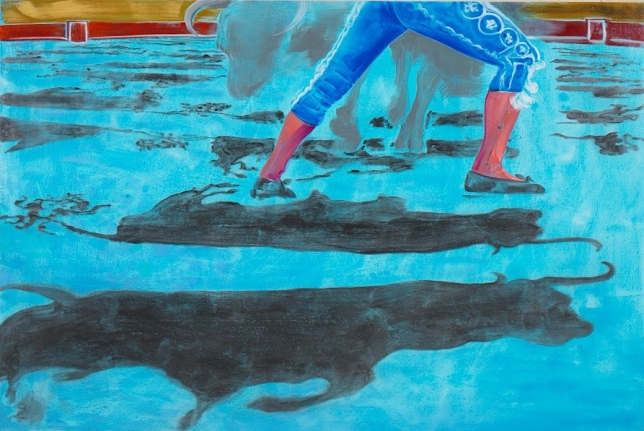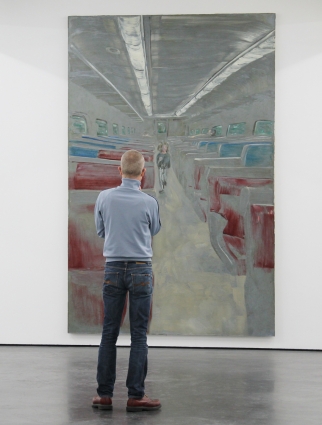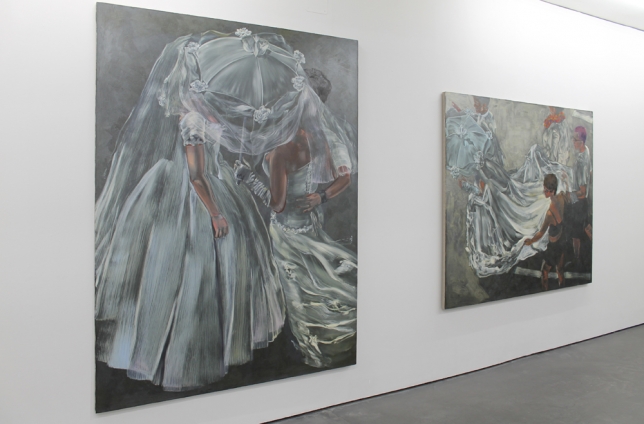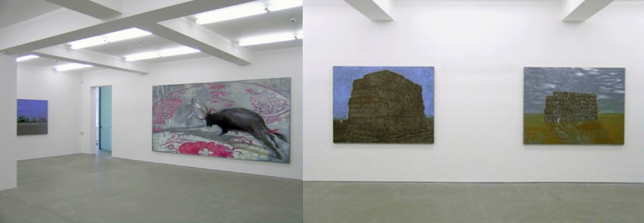24.10. - 22.11.2008
Ena Swansea
Solo exhibition at Arndt & Partner, Zurich
Ena Swansea
Born in Charlotte, North Carolina, USA
Lives and works in New York City, USA
“As if it had corroded through time...” is how the painter Luc Tuymans describes the work of his American colleague Ena Swansea, who creates this effect by grounding her canvasses with graphite before painting on them in oils. The paint application is translucent and the brushstrokes remarkably wide; so wide that the question spontaneously occurs as to how such forthrightness can give rise to so realistic an impression. The answer probably lies in the graphic effect of the individual streaks of color in the brushstrokes and the way they cling to a form as if wanting to mould it.
The images disintegrate into two color dimensions: the hastily receding blackish gray and the bright colors that rush towards the viewer and give form to the motif. Between these two color values unfolds a void that borders on the uncanny. One is reminded of those films where entities are unseen but nevertheless exert their influence. Props are used to define them visually: items of clothing enfolding invisible bodies; articles held by invisible hands. In Swansea’s paintings, too, the uncanny dwells in the void, though not as a personified creepiness, but rather as a kind of abstract emptiness, a sense of disquiet. She swathes her figures in paint in order to allow them emerge into visibility.
Besides solo shows in galleries in New York and Berlin, her work has been featured in important solo exhibitions, such as "Psycho: 41 Paintings from 2002-2011 in European Collections" at Deichtorhallen, Sammlung Falkenberg, Hamburg, Germany (2011) and at Musée d’art moderne Grand-Duc Jean, Luxembourg (2008). Swansea participated in group exhibitions, such as "And those who were seen dancing were thought to be insane by those who could not hear the music" at the Freidman Benda Gallery, New York, USA (2013), "Printer's Proof" at the Bertrand Delacroix Gallery, New York, USA (2011), "True Romance: Allegories of Love from the Renaissance to the Present" at Kunsthalle Wien, Austria, at Villa Stuck, Munich, Germany and Kunsthalle Kiel, Kiel, Germany (2008/07), "IDYLLE" at Sammlung Falckenberg, Hamburg, Germany and National Gallery, Prague, Czech Republic (all 2007), "Greater New York 2005" at the PS1 MoMA, Long Island City, NY, USA, "Story-Tellers" at the Hamburger Kunsthalle, Hamburg, Germany and "Slices of Life: Blueprints of the Self in Painting" at the Austrian Cultural Forum, New York, USA (all three 2005).
Parallel to her 2008 solo show at the Musée d'Art Moderne (MuDAM), Luxembourg, she presented her first solo exhibition in Switzerland at Arndt Partner Zurich.
EXHIBITIONS:
29.4. - 30.5.2010
“Changing The World”
Group exhibition with works by Erik Bulatov, Sophie Calle, William Cordova, Wim Delvoye, Anton Henning, Thomas Hirschhorn, Ilya und Emilia Kabakov, Jitish Kallat, Jon Kessler, Karsten Konrad, Julije Knifer, Enrique Martinez Celaya, Josephine Meckseper, Vik Muniz, Muntean Rosenblum, Julian Rosefeldt, Charles Sandison, Dennis Scholl, Nedko Solakov, Hiroshi Sugito, Ena Swansea, Mathilde Ter Heijne, Keith Tyson, Ralf Ziervogel
at ARNDT, Berlin
24.10 – 22.11.2008
Ena Swansea
Solo exhibition at Arndt & Partner, Zurich
 Ena Swansea, bullfight, 2010, oil and graphite on canvas, 121,92 x 182,88 cm | 48 x 72 in, # SWAN0040
Ena Swansea, bullfight, 2010, oil and graphite on canvas, 121,92 x 182,88 cm | 48 x 72 in, # SWAN0040 Ena Swansea selected for the “Corrida Goyesque”
 Ena Swansea, Rendering for "Goyesque project", Arles 2010
Ena Swansea, Rendering for "Goyesque project", Arles 2010
For the last few months I’ve been working on an exceptional, odd, outsized and kind of unique project.
It’s an extended contemplation on two fields: the ritual and culture of bullfighting and opera brought together, via my own hot-house flower kind of approach.
The inspiration and the site for these projects is the antique and notable Roman arena of Arles, France. It was built in about 1 B.C and has now been magnificently restored. It holds 25,000 people.
The project will unfold in two parts. For the first event in September, I am honored to be the only American artist ever selected to create the “Goyesque,” a giant sand painting covering the entire floor of the arena, roughly the scale of a football field. For one day, this ancient arena becomes my canvas for a monumental and site specific painting, that will be executed overnight, unveiled in the morning, and dissipate by afternoon.
In the tradition of ‘Corrida Goyesque,’ named in honor of Francisco Goya, starting at 5 pm, step by step, vuelta after vuelta, the slow but sure annihilation of my sand painting will be enacted under the ephemeral choreography created by matadors and bulls. By 8 pm the painting will be no more.
At the other end of the arena, there will be an orchestra and 200-person choir, performing a section of the opera Carmen, before the bullfight begins.
Since childhood, this culture has occupied my imagination and created a desire to think about its mystery, through images. Bullfighting remains enigmatic, and even has shown itself to be more so, during the past year as I made a continual study about this ritual. First there is the feeling that one can never know the bull. He has charged throughout history, alone or mythically saddled with a man’s body from the neck down, (as Picasso imagined himself, the magnetically irresistible Minotaur, etc) and the legs of a domesticated servant. During the faena, the last part of the bullfight, we most poetically see two figures tightly entwined, before the touch of death.
“Young men dream of wrapping the bull around their waist.” - Garcia Lorca
This project searches for a place in contemporary art where the ancient art of corrida is alive and in the world today.
Part 2 of my work in this site will occur in June, 2011 and will be installed in the 60 upper arches of the same arena.
Here I hope to address the architecture of this building itself, ornamenting it, as the Romans did. Just as my painterly action will remain only fleetingly as a fixed composition until the dramatic and unpredictable corrida takes the stage, the activity of the city surrounding these arches has changed dramatically over the course of many centuries in time. Long ago the requisite Roman statues that stood in these upper arches were knocked out, and now, the newly glowing stone has been restored and readied to support art, just as it did when it was first built. Thus, I will install a series of character personifications, echoing the missing statues, to dramatically revive a classic narrative that also originates from this setting.
Based on Georges Bizet’s opera Carmen, which concludes with Carmen’s death in front of a bullfighting arena, my version for Arles will star the actress Isabelle Huppert as Carmen. In June I produced the initial photo shoot for this project in Paris.
The piece can be revealed through the 60 arches in contemporary cinematographic time, as 60 frames of film. It asks for comparison to Roman temple friezes, where the action unfolds in chopped up moments, perhaps repeating an action, perhaps moving forward in the jumping progression of Proust's magic lantern.
This installation is a meditation on the opera, converted into contemporary art. In a way it is Carmen without music. But there will be some music. As part of the project, renowned Flamenco guitarist and composer Gregorio Ibor-Sanchez will write a transposed Carmen, allowing the story to reassert itself with a very different, Gypsy musical foundation. This special contribution to the Arles project will be performed at the opening in June 2011. - Ena Swansea
PSYCHO – ENA SWANSEA & ROBERT LUCANDER
OPENING: FRIDAY, 16 December 2011 at 7 pm
DURATION: 18 December 2011 to 25 March 2012
The Sammlung Falckenberg will bring together US painter Ena Swansea and works by Finnish artist Robert Lucander who now lives in Berlin.
For further enquiries about Ena Swansea please contact info@arndtberlin.com and also visit the website www.sammlung-falckenberg.de
Exhibitions
PRESS RELEASE
Arndt & Partner Zurich is delighted to present the first solo exhibition in Switzerland of US artist Ena Swansea.
"As if it had corroded through time..." is how the painter Luc Tuymans describes the work of his American colleague Ena Swansea, who creates this effect by grounding her canvasses with graphite before painting on them in oils. The paint application is translucent and the brushstrokes remarkably wide; so wide that the question spontaneously occurs as to how such forthrightness can give rise to so realistic an impression. The answer probably lies in the graphic effect of the individual streaks of color in the brushstrokes and the way they cling to a form as if wanting to mould it. This corresponds to a stylistic technique used in etching or copper engraving, where the dark-gray opalescent priming shines through everywhere. Swansea's swathes of paint - often in pastel tones of pink, yellow orgreen - flicker like will-o'-the-wisps across a base that is receding into the depths.
The images disintegrate into two color dimensions: the hastily receding blackish gray and the bright colors that rush towards the viewer and give form to the motif. Between these two color values unfolds a void that borders on the uncanny. One is reminded of those films where entities are unseen but nevertheless exert their influence. Props are used to define them visually: items of clothing enfolding invisible bodies; articles held by invisible hands. In Swansea's paintings, too, the uncanny dwells in the void, though not as a personified creepiness, but rather as a kind of abstract emptiness, a sense of disquiet. She swathes her figures in paint in order to allow them emerge into visibility.
Swansea's works are portraits of contemporary society in the broadest sense, beginning with the city and its all-encompassing commercialization, its squares defined by advertising billboards and used for large public parades, and ending with human encounters without relationships, where people confront one another like ghosts of themselves. Elements of reflection and reverberation appear in her work repeatedly. This sort of mirroring is also a reflection on the creation of images per se, as it refers to the basic foreignness between an object and its mirror image, which oppose each other like the sign and the object in classical semiotics. Who doesn't know the sense of strangeness emanating from one's own reflection, whose simple horizontal inversion means we can never see ourselves in the mirror as others see us?
Excerpts from a text by Holger Birkholz, "Dull Mirrors - On Ena Swansea", in: Checkpoint # 6, the gallery review of Arndt & Partner, Berlin / Zürich
Ena Swansea, born in 1965 in Charlotte, North Carolina. Lives and works in New York. Besides solo shows in galleries in New York and Berlin, her work has featured in important group exhibitions, such as "Greater New York", P.S.1 Contemporary Art Center, New York, "Goetz meets Falckenberg", Sammlung Falckenberg, Hamburg (both 2005), "The Triumph of Painting III", Saatchi Gallery, London (2006), "Back to the Figure. Contemporary Painting", Museum Franz Gertsch, Burgdorf (2006), and "True Romance. Allegories of Love from the Renaissance to the Present", Kunsthalle Wien (2007/2008). Her solo show at the Musée d'Art Moderne (MuDAM) in Luxemburg opens in October 2008 (10/11/2008 - 02/02/2009).


